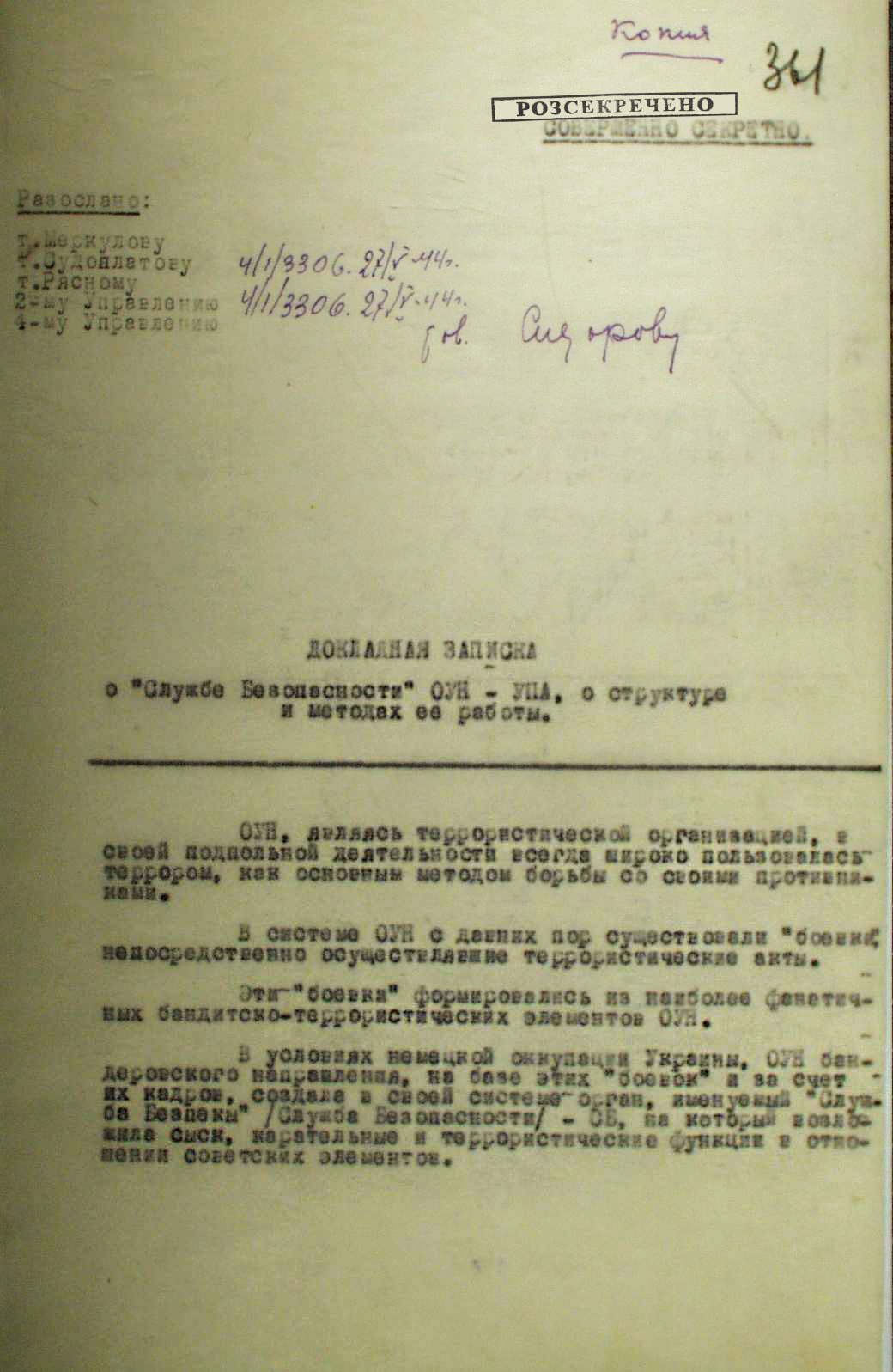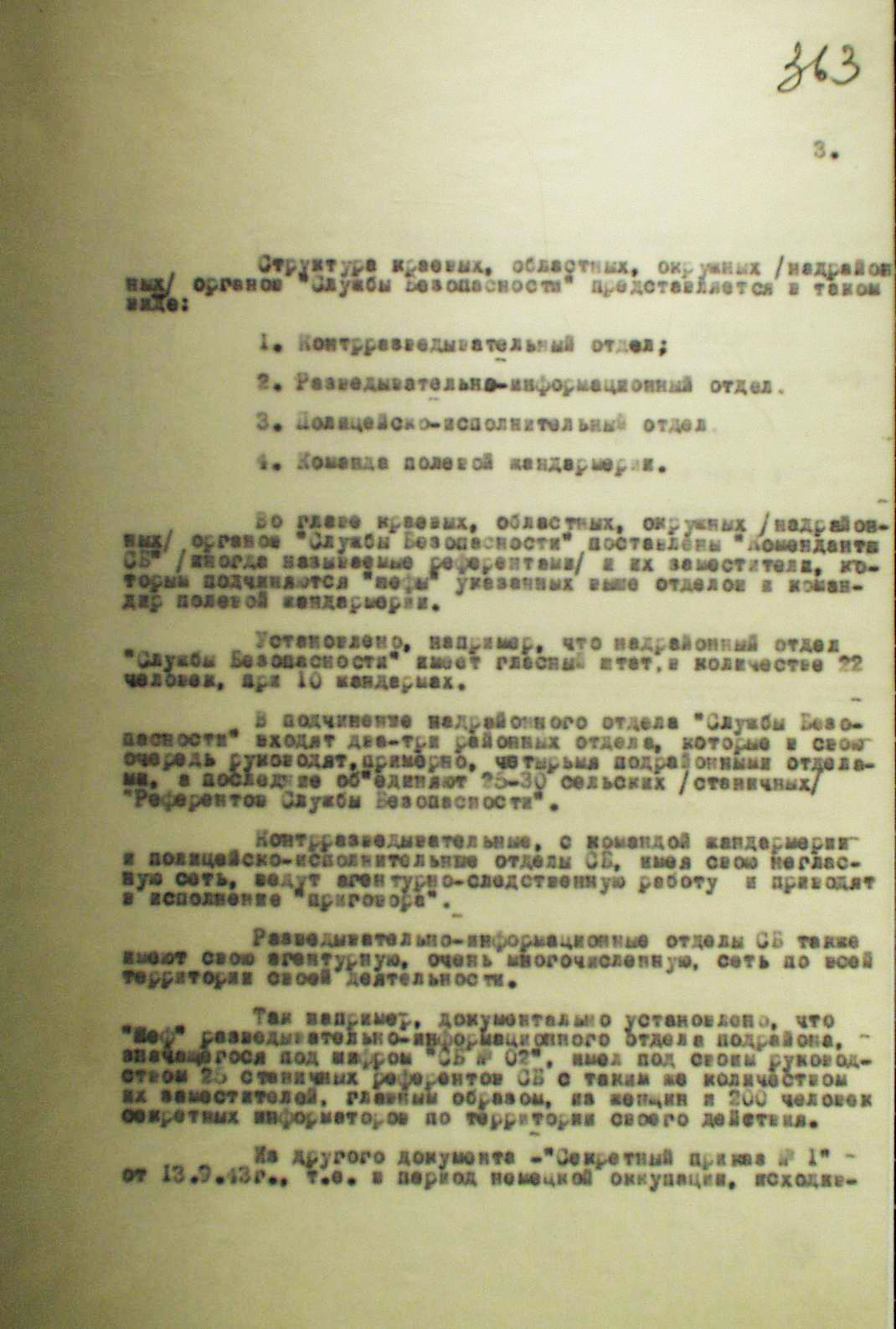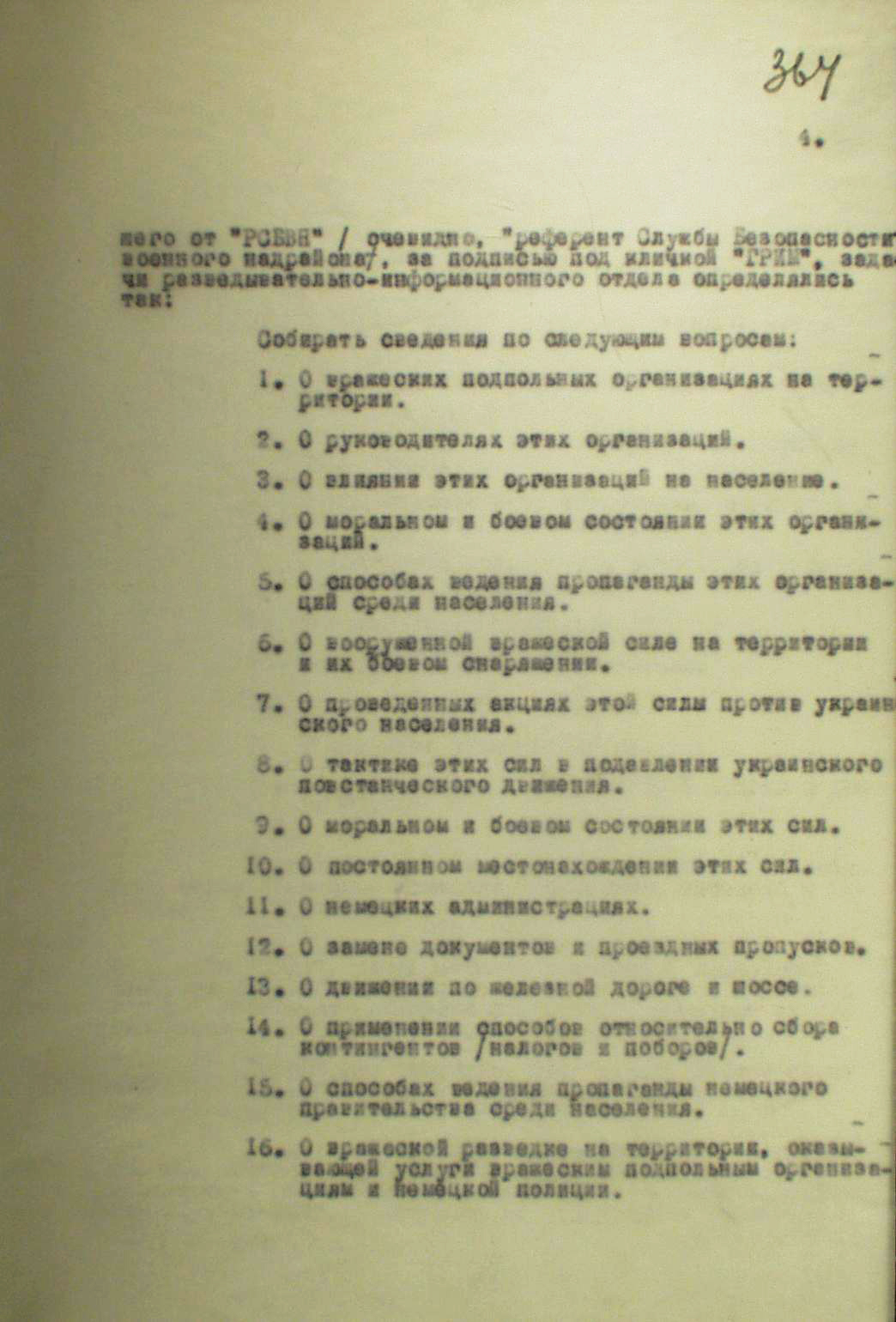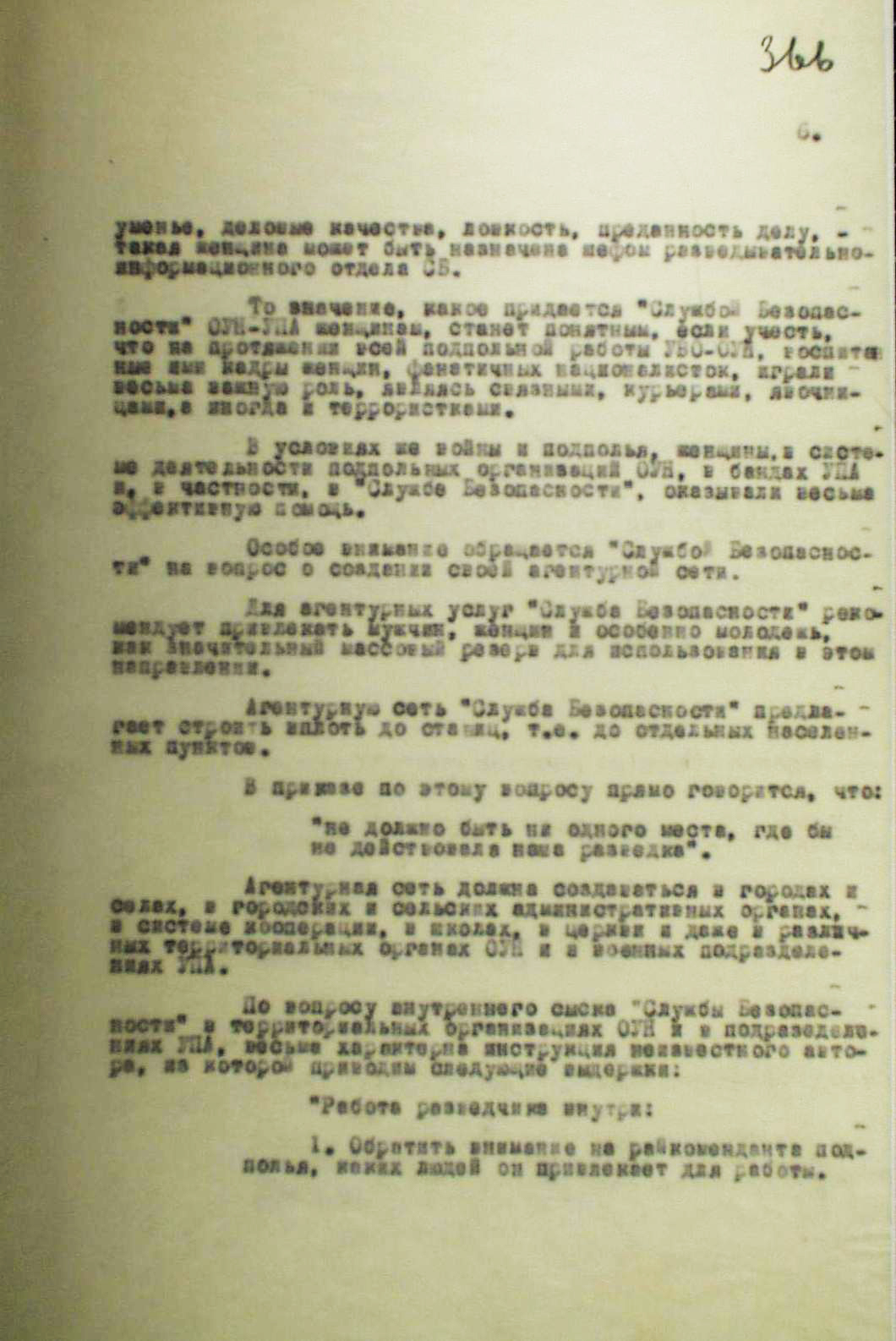Intelligence in the Structure of the UPA Security Service
1/23/2024

In the archives of the Foreign Intelligence Service of Ukraine, materials have been found that testify about the national liberation movement leaders’ thorough approach to the organization and implementation of intelligence activities of the Ukrainian Insurgent Army during the Second World War. Today, these documents, despite the fact that they were compiled in the depths of the nkgb and presented as negative and tendentious information about the insurgent movement of that time, are a kind of source for further research into the history of Ukrainian Intelligence.
Functioning of intelligence units in the structure of the UPA is a separate important page in the history of Ukrainian Intelligence. On the basis of the materials found in the archives and already studied, we can talk about its originality and features inherent only to it. The new documents complement and concretize the existing research.
Thus, in May 1944, a large memorandum entitled “On the “Security Service” of the OUN-UPA, on the Structure and Methods of Its Work” was prepared under the signature of people's commissar of state security of the Ukrainian ssr Serhiy Savchenko. The document was intended to bring to the attention of all units of the nkgb, which at that time launched work on the destruction of the Ukrainian organized underground, how this special service of the UPA was organized, how it managed to learn about everything that was happening in the territories under its control, and why it was so difficult to counteract it.
A lot of space in the memorandum is devoted to the activities of the UPA intelligence. As a result of punitive actions, the nkgb managed to seize a number of instructions on the organization of the work of the insurgent intelligence. Some of them are quoted and retold in detail. In particular, the instruction on intelligence work states that in order to exist, the state organism must see, hear and know everything. And these functions should be provided by intelligence, which “must be invisible in order to be able to act successfully where its interference is needed”.
According to the documents, the Intelligence and Information Department had to be in the structure of the regional, district, supra-district bodies of the Security Service (SB – from Ukrainian Sluzhba Bezpeky – Transl.) of the UPA on a par with Counterintelligence, Police-Executive Departments and Field Gendarmerie teams. The Intelligence and Information Department of the Security Service had a large network of agents in the area of its activities. An example is given that the head of such a department of the sub-district, which was listed under the code “SB No. 02”, had under his command 25 stanytsia (village or part of a larger village- Transl.) referents of the SB with the same number of deputies, mostly women, and 200 secret informants in the territory of his activities.
The “Secret Order No. 1” of 13.09.1943, signed by the referent of the SB under the pseudonym “Hrim”, mentions the tasks of the Department:
“Collect information on the following issues:
1. On enemy underground organizations on the territory.
2. On the leaders of these organizations.
3. On the impact of these organizations on the population.
4. On the moral and combat condition of these organizations.
5. On these organizations’ methods of propaganda among the population.
6. On the enemy’s armed force on the territory and its combat equipment.
7. On this force’s actions against the Ukrainian population.
8. On these forces’ tactics to suppress the Ukrainian insurgent movement.
9. On these forces’ moral and combat condition.
10. On the permanent location of these forces.
11. On German administrations.
12. On the changes in documents and travel passes.
13. On the traffic on railways and motorways.
14. On the methods of collecting taxes and requisitions.
15. On the German government’s methods of propaganda among the population.
16. On enemy intelligence in the territory that provides services to enemy organizations and the German police.
17. About seksots (from russian SEKretnyi SOTrudnik – secret employee, kgb- controlled informer- Transl.) and enemy minions (prepare detailed lists of seksots).
18. On unstable elements that can harm the UPA...”
28 points in total.
After analyzing the information received, as stated in the order, the SB referents select materials on the persons in respect of whom it is necessary to conduct an investigation, and hand them over for further work to the police executive departments.
Emphasis is placed on the fact that great importance is attached to the participation of women in the work of intelligence and information departments. In this regard, one of the orders states that there must be at least one woman in the district department and, in case of skill, business qualities, dexterity, dedication, this woman can be appointed Chief of the Intelligence and Information Department of the SB.
The nkgb report states that “the importance attached by the “Security Service of the OUN-UPA” to women will become clear if we take into account that throughout the entire underground work of the UVO-OUN, the cadres of women educated by them, fanatical nationalists, played a very important role, were liaisons, couriers, and keepers of secret addresses...”
On the coverage of the area by agents, the order of the Security Service states that “there should not be a single place where our intelligence would not operate... An agent network should be created in cities and villages, in urban and rural administrative bodies, in the system of cooperation, in schools, in churches, and even in various territorial bodies of the OUN and in military units of the UPA”.
On the example of the directive instruction of the supra-district referent of the Security Service under the pseudonym “Pidkova”, it is told about the duties of an intelligence officer to monitor the enemy's forces in the area of his responsibility. In particular, in case of detection of armed detachments of the enemy, the intelligence officer is obliged to urgently inform the command of the UPA and his immediate superior. At the same time, there is a requirement that the messenger with this news “move at a speed of at least 10 km per hour”. At the same time, the intelligence officer had to activate all the agents available to him for comprehensive surveillance of the movement of the armed detachment. After the armed formation leaves the territory, the intelligence officer must write a detailed report on his presence and actions, as well as organize surveillance of further movements through his agents.
It is pointed out that, along with the surveillance of military formations, special attention of the insurgent intelligence had to be paid to the activities of the nkgb bodies, “'trying by all means at its disposal to find out the methods of their work and to identify all the employees... On the basis of this information, the Security Service “develops countermeasures in instructions and directives in order to counteract the work of the nkgb bodies in every possible way”.
In this regard, the memorandum states that the nkgb received instructions for the commanders of the UPA Group “North” and the commanders of the Security Service dated January 5, 1944, signed by the Commandant of the SB of the Group “North”. It recommends not to include defectors from the red army in the UPA units, and if accepted, to keep them away from communications units. Special caution had to be exercised with lone defectors and small groups. In addition, it was recommended “not to deal with civilians from eastern regions of Ukraine who were following the red army units, since these persons are a selected reliable bolshevik element”.
A separate section of the instruction is devoted to the nkgb’s recruitment work. It is emphasized that the nkgb recruits arrested persons, and then releases them and uses them in its work. “It must be remembered”, says the instruction, “that the nkgb (former. nkvd) releases a person arrested for political crimes only when he is fit for intelligence work in favor of the bolsheviks”. The instruction prohibits all such persons from being accepted into the ranks of the UPA, and sets the task for the intelligence and counterintelligence departments to obtain and carefully study information about the forms and methods of work of the nkgb.
According to archival documents, at that time, the practice of signing written commitments by SB intelligence informants became widespread. The commitments included an oath, the assignment of a pseudonym, and a warning of punishment for divulging secrets. The memorandum contains the text of such an obligation:
“I, _______________________, voluntarily undertake to honestly and conscientiously cooperate with the SB, to timely report on all enemies who oppose the Ukrainian people, whoever they are.
I undertake to keep my cooperation with the SB in strict secrecy.
I have been warned that I am responsible before the Revolutionary Court for failure to keep secrets.
I will sign my messages with the pseudonym _____________”.
At the same time, a significant part of intelligence was provided by the local population without such written commitments and without even realizing that they were performing the tasks of the SB intelligence units. The involvement of persons on such a basis was also mentioned in the instructions, as well as other forms of intelligence work. All this made it possible to have complete information on the territory of stay and for many years to resist the much larger forces of the nkgb and military formations of the ussr, the goal of which was the complete destruction of all centers of the Ukrainian national liberation movement.
(Source: BSA of the SZR of Ukraine. – F. 1. – Case 7088. – Vol. 1. –P. 361–379).






